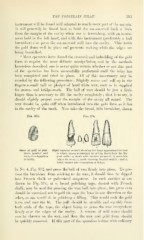Page 393 - My FlipBook
P. 393
THE PORCELAIN INLAY. 391
instrument will be found well adapted to reach every part of the margin.
It will generally be found best to hold the cotton-wool back a little
from the margin of the cavity when one is burnishing, with an instru-
ment held in the left hand, and with this instrument (preferably a ball
burnisher) also press the cotton-wool well into the cavity. This holds
the gold form well in place and prevents rocking while the edges are
being burnished.
" Most operators have found the removal and imbedding of the gold
form to require the most delicate manipulation, and by the methods
heretofore described one is never quite certain whether or not this part
of the operation has been successfully performed until the inlay has
been completed and tried in place. All of this uncertainty may be
avoided by the following procedure : Slightly warm and roll up in the
fingers a small ball or pledget of hard white wax, such as is supplied
for crown- and bridge-work. The ball of wax should be just a little
larger than is necessary to fill the cavity completely; that is to say, it
should slightly project over the margin of the cavity all round. The
wax should be quite stiff when introduced into the gold form as it lies
in the cavity of the tooth. Now take the broad, thin burnisher, shown
Fig. 373. Fig. 374.
Sheet of gold or plat- Right superior central, showing two large approximal cavities
inum, notched and to which access is obtained by cutting freely from the lin-
ready for adaptation gual walls a, tooth with cavities prepared ; b, porcelain
:
to cavity. inlays for same; c, tooth showing lingual surface; and d,
labial surface after cementing of inlays.
in No. 4, Fig. 372, and press the ball of wax firmly into place. To pre-
vent the burnisher from sticking to the wax, it should first be dipped
into French chalk or pulverized soapstone. In such cavities as are
shown in Fig. 374, at (i, broad polishing tape, dusted with French
chalk, may be used for pressing the wax ball into place ; but great care
should be exercised not to pull the tape the least in one direction or the
other, as one would do in polishing a filling. This would rock the gold
form and mar the fit. The pull should be steadily and equably from
both ends of the tape, the object being to press the wax everywhere
firmly over the edges of the cavity. A stream of cold water should
now be thrown on the wax, and then the wax and gold form should
be quickly removed. If this part of the operation is done with ordinary


